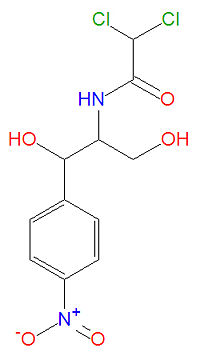Chloramphenicol: Difference between revisions
imported>Milton Beychok (Undo revision 100471687 by David E. Volk (Talk) Undid inadvertant deletion by David Volk) |
mNo edit summary |
||
| (4 intermediate revisions by 2 users not shown) | |||
| Line 1: | Line 1: | ||
{{subpages}} | {{subpages}} | ||
{{TOC|left}} | |||
{{Chem infobox | {{Chem infobox | ||
|align=right | |align=right | ||
| Line 15: | Line 16: | ||
}} | }} | ||
'''Chloramphenicol''' was the first broad-spectrum [[antibiotic]] discovered, in 1947, from ''[[Streptomyces venequelae]]'' cultures. Although it is active against a wide variety of organisms including [[tetracycline]]-resistant [[vibrio]]s, toxicity and safety concerns, such as bone marrow damage and anemia, typically limits its use to only the treatment of very serious infections, such as cholera and typhoid fever. The antibiotic works by binding to bacterial ribosome 50S subunits and inhibiting bacterial protein synthesis. | '''Chloramphenicol''' was the first broad-spectrum [[antibiotic]] discovered, in 1947, from ''[[Streptomyces venequelae]]'' cultures. Although it is active against a wide variety of organisms including [[tetracycline]]-resistant [[vibrio]]s, toxicity and safety concerns, such as bone marrow damage and anemia, typically limits its systemic use to only the treatment of very serious infections, such as [[cholera]] and [[typhoid fever]]. The antibiotic works by binding to bacterial ribosome 50S subunits and inhibiting bacterial protein synthesis. | ||
{| " style="border: solid; center; width:450px;" | |||
!align=left colspan=3 style="background:#{{{color}}}"| "Therapy with chloramphenicol must be limited to infections for which the benefits of the drug outweigh the risks of the potential toxicities. When other antimicrobial drugs are available that are equally effective and potentially less toxic than chloramphenicol, they should be used." <ref>{{citation | |||
| title = Goodman & Gilman's The Pharmacological Basis of Therapeutics | |||
| edition = 9th Edition | |||
| publisher =McGraw-Hill | |||
}}, p. 1133</ref> | |||
|- | |||
|} | |||
== Chemistry == | == Chemistry == | ||
Chloroamphenicol, or 2,2-dichloro-N-[1,3-dihydroxy-1-(4-nitrophenyl)propan-2-yl]acetamide, has molecular formula C<sub>11</sub>H<sub>12</sub>Cl<sub>2</sub>N<sub>2</sub>O<sub>5</sub> and molecular mass 323.1294 g/mol. The drug is referred to by several names, including CAF, CAM, CAP, chloramphenicole, chloramfenikol, chloroamphenicol, cloroamfenicolo, CPh, D-Chloramphenicol. | Chloroamphenicol, or 2,2-dichloro-N-[1,3-dihydroxy-1-(4-nitrophenyl)propan-2-yl]acetamide, has molecular formula C<sub>11</sub>H<sub>12</sub>Cl<sub>2</sub>N<sub>2</sub>O<sub>5</sub> and molecular mass 323.1294 g/mol. The drug is referred to by several names, including CAF, CAM, CAP, chloramphenicole, chloramfenikol, chloroamphenicol, cloroamfenicolo, CPh, D-Chloramphenicol. | ||
==Indications== | |||
Uses approved by the U.S. [[Food and Drug Administration]] are: ''[[Bacteroides]]'' brain sbscess, boutonneuse Fever, ''[[Hemophilus influenzae]]'' meningitis, ''[[Neisseria meningitidis]]'' meningococcal meningitis, [[paratyphoid fever]], [[rickettsia]]l infection, streptococcal meningitis, [[typhoid fever]]; unlabeled but recognized uses include [[Clostridium perfringens]] [[gas gangrene]], [[glanders]], [[plague]], [[ehrlichiosis]], non-cutaneous [[anthrax]] and [[tularemia]]. In combination with [[doxycycline]] and [[co-trimoxazole]], it is used for [[melioidosis]]. | |||
==Preparations== | |||
For systemic disease, the drug may be given orally or intravenously, although oral preparations are no longer available in the US. An opthalmic ointment is used for bacterial conjunctivitis, and is over-the-counter in the UK but on prescription in the US. | |||
== References == | == References == | ||
{{reflist}} | |||
{{CZMed}}[[Category:Suggestion Bot Tag]] | |||
Latest revision as of 06:01, 28 July 2024
|
| |||||||
| chloramphenicol | |||||||
| |||||||
| Uses: | antibiotic | ||||||
| Properties: | |||||||
| Hazards: | toxicity | ||||||
| |||||||
Chloramphenicol was the first broad-spectrum antibiotic discovered, in 1947, from Streptomyces venequelae cultures. Although it is active against a wide variety of organisms including tetracycline-resistant vibrios, toxicity and safety concerns, such as bone marrow damage and anemia, typically limits its systemic use to only the treatment of very serious infections, such as cholera and typhoid fever. The antibiotic works by binding to bacterial ribosome 50S subunits and inhibiting bacterial protein synthesis.
| "Therapy with chloramphenicol must be limited to infections for which the benefits of the drug outweigh the risks of the potential toxicities. When other antimicrobial drugs are available that are equally effective and potentially less toxic than chloramphenicol, they should be used." [1] |
|---|
Chemistry
Chloroamphenicol, or 2,2-dichloro-N-[1,3-dihydroxy-1-(4-nitrophenyl)propan-2-yl]acetamide, has molecular formula C11H12Cl2N2O5 and molecular mass 323.1294 g/mol. The drug is referred to by several names, including CAF, CAM, CAP, chloramphenicole, chloramfenikol, chloroamphenicol, cloroamfenicolo, CPh, D-Chloramphenicol.
Indications
Uses approved by the U.S. Food and Drug Administration are: Bacteroides brain sbscess, boutonneuse Fever, Hemophilus influenzae meningitis, Neisseria meningitidis meningococcal meningitis, paratyphoid fever, rickettsial infection, streptococcal meningitis, typhoid fever; unlabeled but recognized uses include Clostridium perfringens gas gangrene, glanders, plague, ehrlichiosis, non-cutaneous anthrax and tularemia. In combination with doxycycline and co-trimoxazole, it is used for melioidosis.
Preparations
For systemic disease, the drug may be given orally or intravenously, although oral preparations are no longer available in the US. An opthalmic ointment is used for bacterial conjunctivitis, and is over-the-counter in the UK but on prescription in the US.
References
- ↑ Goodman & Gilman's The Pharmacological Basis of Therapeutics (9th Edition ed.), McGraw-Hill, p. 1133
The most up-to-date information about Chloramphenicol and other drugs can be found at the following sites.
- Chloramphenicol - FDA approved drug information (drug label) from DailyMed (U.S. National Library of Medicine).
- Chloramphenicol - Drug information for consumers from MedlinePlus (U.S. National Library of Medicine).
- Chloramphenicol - Detailed information from DrugBank.
